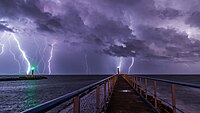
Photo from wikipedia
Abstract Long-period pulse-like ground motions in the near-field are likely to induce severe damage to large structures due to resonance at the natural frequencies of engineered construction. To investigate the… Click to show full abstract
Abstract Long-period pulse-like ground motions in the near-field are likely to induce severe damage to large structures due to resonance at the natural frequencies of engineered construction. To investigate the origin and characteristics of large velocity pulses from the seismic source, this study identifies 14 stations with velocity pulses from 32 strong-motion seismographs located in the near-field of the Imperial Valley MW 6.5 earthquake. The pulse-like ground motions are simulated by a kinematic approach using a fourth-order accurate finite-difference method. The results show that the slip asperity in the northern part of the fault plane contributes more to large velocity pulses than the asperity that originates in the hypocentral zone. The two-sided pulses on the fault-normal component and the one-sided pulses on the fault-parallel component are mainly regulated by the fault rupture and slip directions, respectively. Compared with the pseudo-velocity response spectrum, the displacement response spectrum better captures the resonance effect of long-period pulse-like ground motion on large structures. The location of the maximum ground motion coincides with the surface projection area of the large asperity, and the amplitude and the attenuation rate of each horizontal component vary with increasing distance from the fault. The difference in the ground motion peaks on both sides of the fault implies that the fault-normal component is more sensitive to the fault dip angle than the fault-parallel component. We reproduce the pulse-like ground motions up to 1 Hz by fitting the simulated velocity time histories, response spectrum and ground motions to observed data. Using the pulse records of the Imperial Valley earthquake, the 1994 Northridge MW 6.7 earthquake, and the 1999 Chi-Chi MW 7.6 earthquake, we compare the effects of earthquake magnitude on peak value and distribution of large velocity pulses, in which a reasonable consistency can be observed. Our simulated results of near-field pulse-like ground motions are beneficial to clarify the pulse mechanism.
Journal Title: Soil Dynamics and Earthquake Engineering
Year Published: 2020
Link to full text (if available)
Share on Social Media: Sign Up to like & get
recommendations!